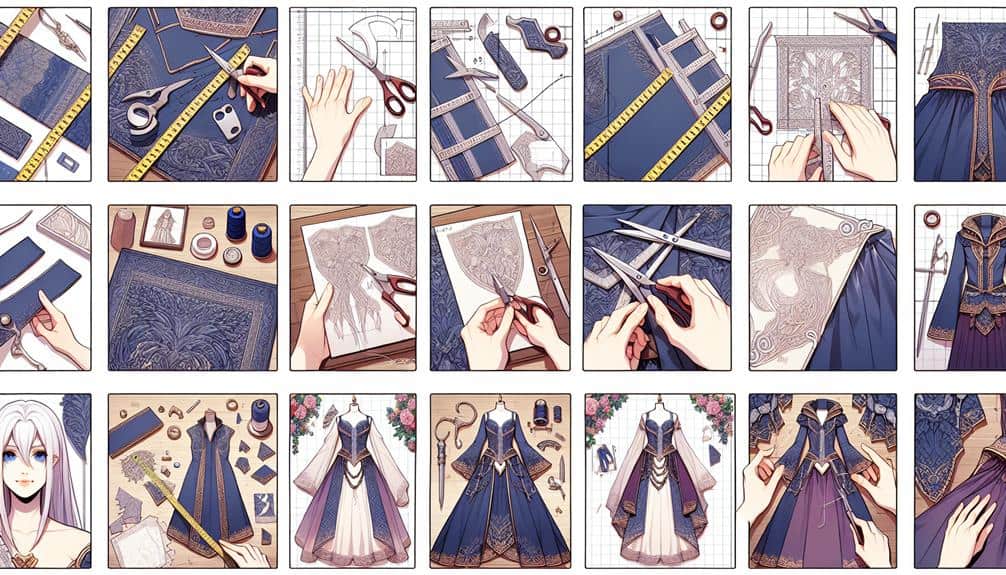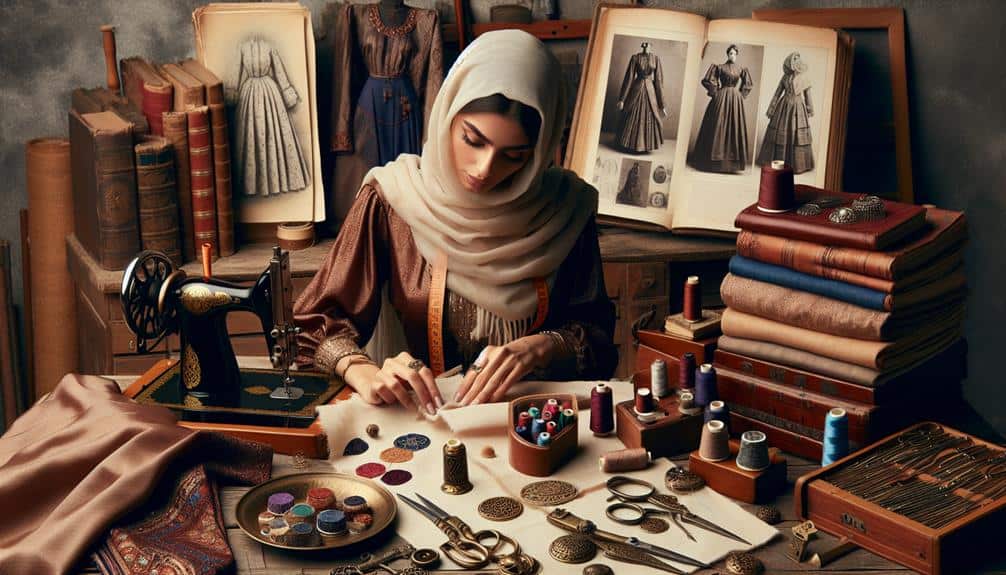When creating a cosplay costume, the devil is in the details. Imagine transforming a plain foam sheet into a realistic-looking leather belt or turning a simple headband into an elaborate crown fit for royalty.
The key to achieving these transformations lies in mastering the techniques for crafting costume accessories. By honing your skills in material selection, cutting precision, painting finesse, texture creation, and securing methods, you can elevate your costume game to a whole new level.
But how do you guarantee your accessories stand out from the rest and truly enhance your overall look?
Key Takeaways
- Choose durable materials that align with design vision
- Focus on precise cutting and pattern making for accuracy
- Experiment with painting techniques for vibrant finishes
- Incorporate diverse textures and details for unique accessories
Choosing the Right Materials
When crafting costume accessories, make sure you select materials that not only match your design vision but also offer durability and authenticity. Material selection plays a critical role in bringing your costume accessory to life while staying within budget constraints. Consider the fabric options available to you, keeping in mind the durability factors each one presents.
Incorporating budget constraints into your material selection process requires a strategic approach. You may need to balance the cost of materials with the overall quality and authenticity you aim to achieve. Researching different fabric options can help you find the perfect balance between cost-effectiveness and durability. For example, synthetic fabrics may offer a more budget-friendly option compared to natural fibers like silk or leather.
Durability factors shouldn't be overlooked when choosing materials. Depending on the intended use of your costume accessory, factors such as strength, flexibility, and resistance to wear and tear should all be considered. By carefully evaluating these aspects, you can make sure that your costume accessory not only looks authentic but also withstands the test of time.
Precision Cutting Techniques
To elevate your costume accessory creation process to a new level of craftsmanship, mastering precision cutting techniques is key. Perfecting your cutting skills won't only make your accessories look more professional but also guarantee a more polished final product.
Here are three essential tips to help you improve your precision cutting techniques:
- Invest in Quality Tools: Using sharp scissors, rotary cutters, or precision knives can make a significant difference in the accuracy of your cuts. Make sure to maintain the sharpness of your tools for cleaner edges.
- Master Pattern Making: Creating precise patterns is essential for accurate cutting. Take your time to draft and adjust patterns to fit your design perfectly before cutting your materials. This step will save you time and materials in the long run.
- Explore Embellishment Ideas: Precision cutting opens up a world of possibilities for embellishing your accessories. Experiment with intricate cutouts, layered designs, or geometric shapes to add uniqueness and flair to your creations.
Painting and Coloring Tips
Enhance the vibrancy and depth of your costume accessories by mastering painting and coloring techniques that bring your creations to life.
When painting your costume pieces, consider blending colors to achieve a seamless shift between different hues. Start by selecting a primary color and gradually mix in small amounts of a secondary color to create a smooth blend. Experiment with different ratios until you achieve the desired effect.
Creating gradients can also add dimension to your accessories. Begin by applying a base color and then gradually lighten or darken the shade as you move across the surface. This technique can make your accessories look more dynamic and visually interesting.
Remember to use thin layers of paint to avoid clumping or streaking, ensuring a professional finish. By mastering the art of blending colors and creating gradients, you can take your costume accessories to the next level, making them truly stand out in any costume ensemble.
Adding Textures and Details
Let your costume accessories come alive with intricate textures and enchanting details that elevate your overall look to new heights. Adding embellishments and creating depth can truly transform your accessories from ordinary to extraordinary.
Here are three exciting ways to enhance your costume accessories:
- Layering Textures: Experiment with different materials like feathers, sequins, beads, or fabric to create visually appealing layers. Combining textures adds depth and complexity to your accessories, making them stand out.
- Intricate Embroidery: Consider adding embroidery details to your accessories for a touch of elegance and sophistication. Intricate stitching patterns can bring a unique flair to your costume pieces, making them one-of-a-kind.
- Mixed Media Magic: Embrace the art of mixing different media such as metal charms, ribbons, or lace to add a dynamic element to your accessories. Mixing materials can create a rich tapestry of textures that catch the eye and make your costume truly special. Let your creativity run wild, and watch as your accessories become the highlight of your ensemble.
Securing and Attaching Accessories
As you take your costume accessories to the next level, ensuring they stay securely in place is key to completing your ensemble with finesse. There are various attaching methods you can utilize to make sure your accessories stay put throughout your event or performance. For lightweight accessories like feathers or small embellishments, hot glue or fabric glue can be effective options. These adhesives provide a strong hold without adding bulk or weight to your accessory.
For more substantial accessories such as hats or bags, sewing them onto your costume might be a better choice. This method considers a secure attachment that can withstand movement and activity. Be sure to use a sturdy thread and needle to prevent any mishaps during wear.
Additionally, safety precautions should always be taken into consideration when attaching accessories. Avoid using sharp objects near your skin and be mindful of potential choking hazards, especially if your costume accessories are intended for children or pets. By following these tips, you can confidently secure your costume accessories and showcase your creativity with peace of mind.
Frequently Asked Questions
How Can I Ensure My Costume Accessories Are Durable and Long-Lasting?
To guarantee your costume accessories endure, choose quality materials and master finishing techniques. Store them properly to avoid damage. Regular maintenance, like gentle cleaning and repairs, will keep your creations looking fabulous for years.
Are There Any Special Techniques for Creating Realistic Weathering Effects on Costume Accessories?
To create realistic weathering effects on costume accessories, try using techniques like dry brushing, sponge painting, and strategic sanding. Experiment with different layers and colors to achieve an authentic aged look.
What Are Some Creative Ways to Incorporate Lighting or Special Effects Into Costume Accessories?
Want to jazz up your costume accessories? Light up embellishments can add that wow factor. Imagine interactive features, sound effects, even holographic elements. Get creative, make heads turn with your next-level accessories!
How Can I Make My Costume Accessories Stand Out and Complement the Overall Costume Design?
To make your costume accessories stand out and complement the overall design, explore various embellishment techniques like beading or appliqué. Focus on color coordination to guarantee harmony and visual impact. Mix textures and elements for a unique look.
Are There Any Advanced Techniques for Creating Intricate Patterns or Designs on Costume Accessories?
To create intricate detailing on costume accessories, consider hand painting for a personal touch. Advanced embellishments like beading or embroidery can add flair. Experiment with textile manipulation techniques for unique designs that elevate your costume creations.

